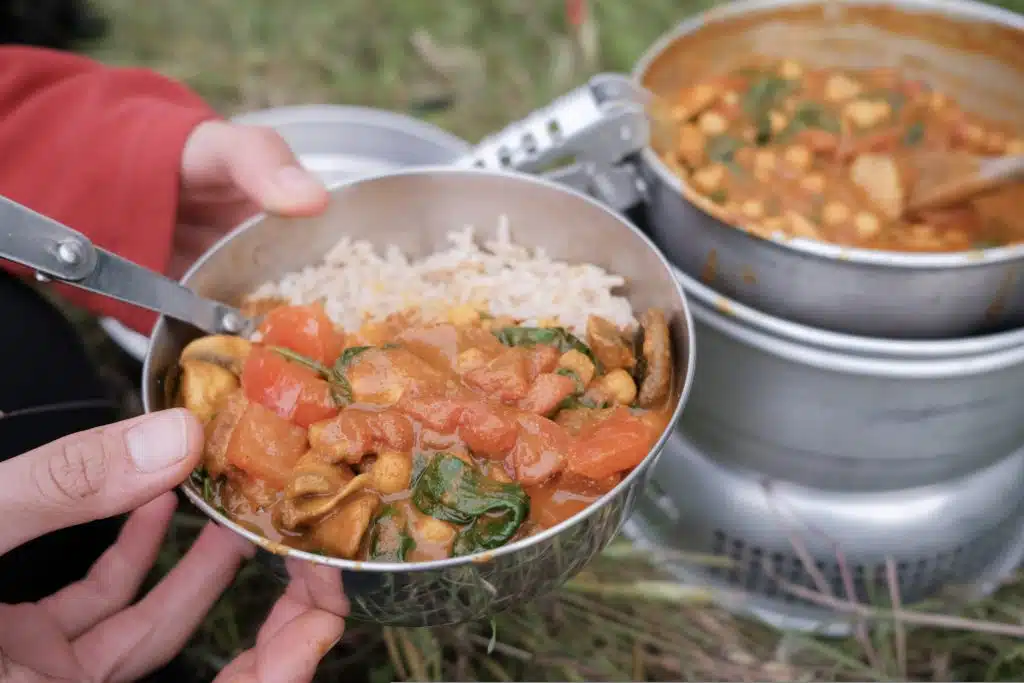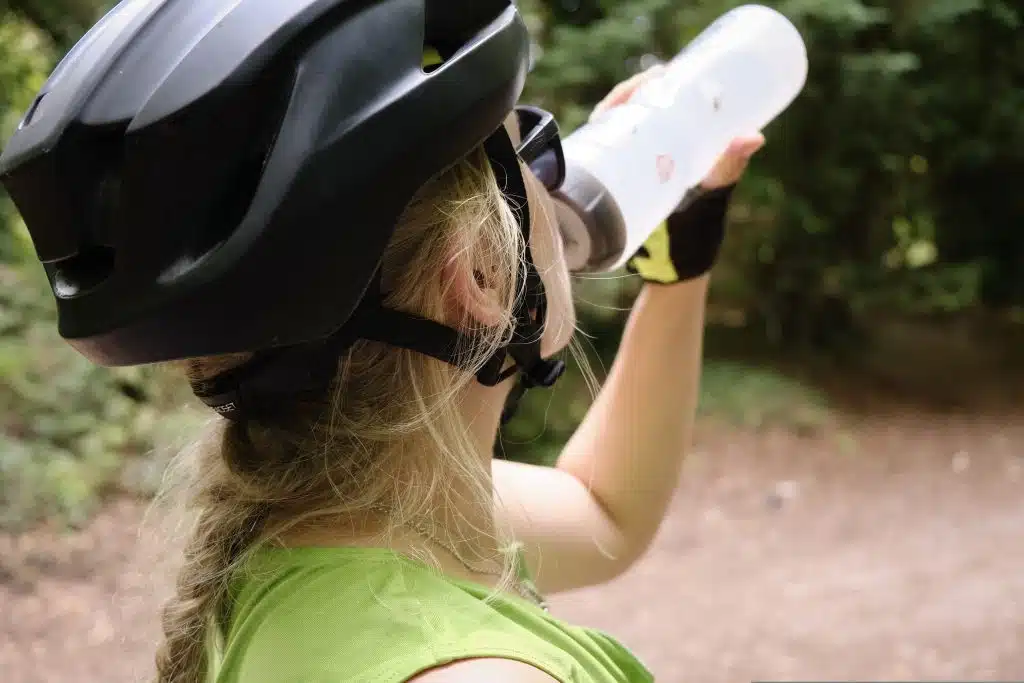18 useful and practical tips to help you stay cool when cycling in the heat and hot weather
The need to stay cool when cycling in the heat is so important. Not only does getting too hot in the saddle cause discomfort but it can also lead to exhaustion and heat stroke.
Riding in the sunshine can be incredible but it does come with some challenges when the heat is extreme.
Inspired by some recent sweaty cycles and the world’s temperatures only rising and set to get hotter, we thought we’d put together these tips for how to stay cool when cycling in the heat. These practical and applicable tips will help to keep you feeling cool, whilst still enjoying rides through the summer.

1. Stay Hydrated and Drink Plenty of Water
It’s always important to stay hydrated and drink plenty of water. This is never truer than when exerting yourself in the saddle. On a hot day, you’ll sweat more and therefore need to drink more.
Get dehydrated and you’ll become tired, which can make pushing those pedals even harder. As dehydration sets in further, it can cause heatstroke, which can lead to further serious health complications.
Don’t wait until you’re thirsty, instead drink often throughout the day to avoid getting dehydrated in the first place.
In the heat, you may need to rethink your water storage option in order to carry more water bottles. On especially hot days or multi-day trips, we bring our Ortlieb 10L water bladder. It’s pretty sturdy and it allows us to bring a lot more water than we could carry in bottles on the bike.
2. Wear Suncream
The benefits of
Sunburn can do more than just sizzle your skin. It can make you feel fatigued quicker and speed up your metabolism. Which, increases your need for food and water, when you’re already dehydrated. It can also lead to heat stroke and heat exhaustion.
Smother yourself in a high-factor

3. Take it Easy
Cycling in the heat will mean you’re working harder and spending more energy than usual, so you’ll likely get tired a lot quicker. Don’t be so hard on yourself for not covering as much distance or as fast as on cooler days.
Take it easy, plan for slower and shorter days to account for the extra effort needed in the heat. Also, think about going easier on the hills to avoid tiring yourself out and getting exhausted.
4. Cool off When You Can
When the opportunity for a midday dip or chance to rest in the shade appears, take it. Biking in hot weather over the course of the day can make your body temperature rise, leading to fatigue quicker.
Cooling off can help to bring your core temperature and make you feel a whole lot lighter.
Ways to cool off could be:
- A dip in a lake, stream or river
- Sitting in the shade
- Wetting your clothing and putting them back on
- Running your wrist under cold water
- Placing a wet towel over you
- Sit with your feet in a stream or cold water
Women’s body temperature rises by roughly half a degree when menstruating so consider this when riding. This isn’t to say you shouldn’t cycle when you’re on your period but it may be important to factor this in when considering rest days and distances.

5. Consider the Time of Day You’re Riding
Check the weather report for the hottest part of the day and plan to rest for that part of the day. It’s usually cooler earlier in the morning and later into the day.
Consider riding at these cooler points in the day and resting through the hottest part of the day inside or under shade to avoid exerting yourself through the hottest part of the day.
Want more adventure fodder, tips and guides for getting outside? Then sign up for our newsletter to get our latest articles and updates
6. What to Wear When Cycling in the Heat
Our instincts tell us to wear as little as possible in the heat but this can leave your skin exposed and at risk of burning.
If you’re cycling in extreme heat, wearing clothing with sweat-wicking technology and ventilation will keep you cool and protected. The sweat-wicking technology pulls the sweat away from your skin and dries quickly, so your clothes don’t feel heavy.
It’s also worth considering wearing suncream underneath mesh clothing to really protect you. Cycling jerseys with zips will help to keep you cool and regulate airflow to your body. Opting for lighter materials and colours will help to keep you cool.
Don’t neglect your noggin either. Although it’s protected with a helmet, it can still be exposed to the sun, so a sunhat underneath will prevent your head from getting too hot.

7. Food is Fuel
What you eat is the fuel that keeps your wheels moving and in the heat, you may find you need more food. As your metabolism is increased you’ll burn through energy quicker and may need more food to keep your energy levels up.
Avoid high salt foods when you’re on the move as these will just dehydrate you. Instead, save them for the end of the day to replace lost electrolytes.
Whilst riding, foods high in water are good and mighty refreshing. Things such as watermelon, grapes and cucumber are good but you may need to think about what you can carry practically.
Our food guides have tons of ideas and recipes for shorter or multi-day rides:
24 Plant-Based Snacks for the Outdoor Adventures
Vegan Bikepacking Food for Overnight and Multi-Day Trips
The Ultimate Guide to Vegan Cycle Touring Food for Long Expeditions and Travel
8. Rest is Crucial
You will be working harder and will feel more tired in the heat. It’s important to listen to your body and get plenty of rest.
This may be more frequent rests during the day, shorter days and more sleep in the evening. It’s important to recuperate after a day’s riding before you do it all over again the next day.
If you’re on a multi-day trip in a particularly hot climate, it’s super important to make sure you’re getting enough rest. Otherwise, you’ll fry and burn out (in all manners of the word), putting a stop to your trip pretty quickly.
When you’re deciding where to pitch for the night, think about where you’re camping in relation to the sunrise. Those early morning rays on your tent will have you feeling suffocated very quickly. Camp by trees or a building that’ll shelter you from the morning sun and heat, so you can get a little more shut-eye.

9. Rehydrate Right
Although water is important, it’s also vital to replace the lost electrolytes you’ve sweated out. You can do this throughout the day with electrolyte tablets in your water bottles or bladder when cycling in extreme heat. You can always have one at the end of the day if you prefer but drinking them throughout the day will help to keep you hydrated as you ride.
After your ride, a protein-based shake or food will help to pull water to your muscles to help them recover quicker.
10. Avoid Getting Eaten Alive
I love almost all elements of summer, apart from the fact I turn into a big tasty snack for all the airborne bugs within a mile radius. Getting bitten affects some people worse than others and unfortunately, I am one of those people.
If like me you turn into a moving buffet in the warmer months, spray on the bug spray to avoid getting eaten alive.
They’re most prevalent at dusk and dawn so plan to be on the move through these parts of the day or covered up so the critters can’t get you.
11. Plan Your Route
Planning where you’re going and when will enable you to plan rests in the shade or near a water source. It’ll also give you the opportunity to plan spots where you can stock up on food and more water.

12. Acclimatise to Cycling in Hot Weather
If you’re diving into an extremely hot climate it’s important to get used to the rise in temperature. Get used to moving in the heat and consider what time of day you ride to ease into the increase in body temperature.
You may consider working out and cycling in warmer weather in the lead-up to a trip in a different climate. Or have a few days in the hot climate to get used to the heat before cycling off the bat.
13. Chamois Cream is Your Friend
In the heat, you sweat more, which can lead to chaffing with the increase of water and salt in your clothing and against your skin.
To avoid any discomfort or worse, slap on the chamois cream in all those nooks and crannies. It’ll relieve any chaff and make the whole ride much more enjoyable. Speaking from experience, saddle sore can lead to some nasty infections and injuries, which do more than make you a bit uncomfortable.
I use Assos which is the upper end of the price scale but it’s amazing. I’ve used a few different brands and have found Assos to be far superior. It stays put and relieves any discomfort. After my injury on our Ride for the Wild, I invested in solutions and this cream is now a firm accompaniment on every trip.
Womens Assos chamois cream Mens Assos chamois cream

14. Cold Drinks Cool You Down
Cold drinks don’t only taste better than warm water, they actually help to cool you down.
Before rides, put half or three-quarter filled bottles in the freezer and top up with water before you ride to keep your drinks and yourself cool. You can also chuck some ice cubes into your bladder to keep your reserve water cool.
If you’re lucky enough to find a friendly cafe or pub, they may give you some ice with your refills. (It’s even more likely if you buy a cider first we’ve found.)
Keep exploring…
10 Eco-Friendly Cycling Tips
The Best Cycling Documentaries on YouTube
Building the Ultimate Bike Tool Kot for Bikepacking and Cycle Touring
All of our cycling, bikepacking and touring content
15. Protect Your Eyes
The sun can really damage your eye so wearing sunglasses will help protect them long-term. Choose sunglasses that are polarised and UV protection to keep your eyes really protected.

16. Put Your Clothes in the Fridge or Freezer
Sounds odd but it can really help to keep you cool if your clothes are cool. If you’re able to, pop them in the fridge or freezer before you ride or whilst you rest. Then when it’s time to get in the saddle, it’ll feel mighty refreshing to have the cool fabric against your skin.
17. Pack Only What You Need
You never really want to be carrying more than you need but in the heat, this is especially true. All that extra weight just causes you to spend more energy at a time when you’re already using more than usual.
Be really ruthless with what you take cycling and only bring what you really need to avoid carrying extra weight. In warmer weather, this is a little easier as you don’t need as much gear or clothing compared to cooler months.

18. Wear Fingerless Gloves
When the weather is warmer, the terrain is drier and more compact. This can mean more impact on you and your bike, especially mountain biking in the heat.
Wearing fingerless gloves can help to reduce the impact on your hands as you ride. They can also relieve any chaff that comes from sweaty palms against your handlebars.





